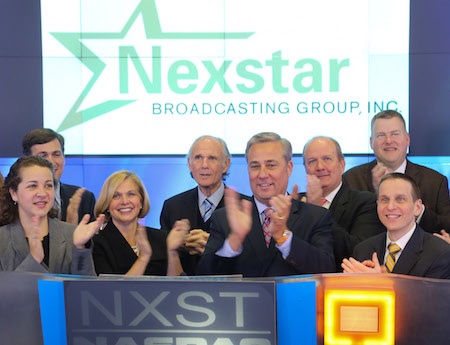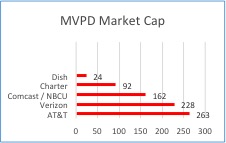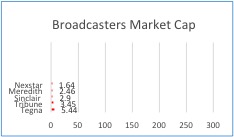Nexstar-Media General Merger No Threat to Public Interest

Related: Scaling the Station Heights, Market-by-Market
If events go as expected, the FCC will approve the merger of Nexstar and Media General in a deal worth nearly $5 billion. The acquisition and absorption of Media General into Nexstar would result in the broadcasting industry’s largest local broadcast group, with 171 stations in 100 markets, reaching 39% of television households in the United States. The new Nexstar Media Group would have a market capitalization of over $6 billion.
While the combined company will usher in some significant changes in broadcasting, there are several reasons why the deal should not be viewed as a threat to the public good. The evolution of the video marketplace and founder, chairman and CEO Perry Sook’s stewardship of Nexstar over its 20-year run mean the merger is fundamentally good news for viewers and the industry alike.
Nexstar Media will emerge as one of the nation’s top providers of local news, entertainment, sports, lifestyle and network programming through its broadcast and digital platforms. The company also stands to bolster its already strong presence in the local advertising market, providing attractive scale and synergies for both large and small advertisers looking to capture eyeballs and wallets.
Related: FCC Majority Votes for Media Ownership Item
Through acquisition, accretion and organic growth, Nexstar’s rise has been something of a textbook study on tight management, lean operations and delivering consistent return to shareholders. Nexstar’s stock regularly shows up on Wall Street buy lists, and its value has grown by 617% over the last five years, far exceeding the 63% performance of the Standard & Poor 500 index.
Retrans and JSAs
While the growth has been admirable, Sook has achieved it with a “stand your ground” stance on retransmission consent fees. While fellow broadcasters have cheered, the posture has generated angst among MVPDs and more than a few blackouts.
Critics of Nexstar, Sinclair Broadcasting and other television groups often point to the blackouts as rationale for FCC intervention. “Good faith” and “totality of the circumstances” are principles of negotiation that critics aver have been elusive in Nexstar contracts, and there have been regular calls for the FCC to step in to resolve retransmission agreements. Supported by the NAB, Nexstar eschews regulatory intervention into what it rightfully calls a private contract.
Related: Perry Sook Is Taking Notes
Nexstar’s adept use of joint sales agreements (JSAs) also has been controversial and prompted an action by the FCC to phase out JSAs by this year. In a stroke of legislative prescience, however, Congress voted to overturn the FCC’s action in its last-minute budget bill of 2015. Nexstar, Sinclair and Howard Stirk Holdings (led by Armstrong Williams) also challenged the FCC’s ownership rules in the Court of Appeals for the 3rd Circuit. The court’s May 25 decision required the FCC to act on its long-overdue quadrennial media ownership rules before it could act on JSAs (which fall under the ownership rules).
Following this series of events, FCC Chairman Tom Wheeler has navigated back to a position wherein JSAs can again be disallowed, this time in the context of the Nexstar-Media General merger. Nexstar is seeking a waiver in order to continue operating JSAs. If fairness rules the day, the FCC should grant such a waiver request.
Related: Nexstar Spinoffs Drive Q2 M&A to $681.2 Million
Spawning New Minority Broadcasters
Nexstar’s legacy of growth would not be complete without acknowledging the role it has played in the creation and development of two of the leading African-American broadcasters in the country. When Nexstar was required to divest stations as part of its 2014 multifaceted acquisition of Gray stations, it chose to sell to an African-American-owned media company led by West Coast publisher Pluria Marshall, Jr. Nexstar’s sale and ongoing support of three full-power television stations in Iowa, Louisiana and Texas has allowed Marshall entrée into the ranks of broadcast ownership.
Following its decision to divest several television stations as part of the Media General merger, Nexstar has once again chosen to empower minority ownership. DuJuan McCoy, a Texas broadcaster and entrepreneur, has purchased two additional stations in Louisiana from Nexstar. At this point, Nexstar—and principally Perry Sook—can take credit for helping to launch five black-owned television stations in the span of two years. While some of the consumer groups have opposed the Nexstar-Media General merger on public interest grounds, none can question the company’s commitment to support minority ownership, a goal that has eluded successive FCC chairmen.
The Public Interest
A series of mega-mergers worth in the tens of billions (AT&T-DirecTV, Charter-Time Warner Cable, Altice-Cablevision) have come to pass during the Wheeler era. They continue the spate of consolidation in the pay television market and have contributed to formidable scale in the delivery of content and broadband to consumers. By contrast, up to now, the largest broadcast television merger in recent years was the $985 million Sinclair-Albritton deal in 2015. While Nexstar’s acquisition of Media General is valued at $4.8 billion, this number is far short of even the smallest recent cable merger (Altice at $17 billion), which begs the question: Why are some groups still opposed?
Under the broadest possible reading of the public interest, opponents of the Nexstar deal have urged the FCC to deny the merger or to impose numerous conditions which would frustrate the purpose of the transaction itself. According to the FCC’s own Office of General Counsel, Congress has directed the Commission to review transactions involving licenses and authorizations under the Communications Act and to determine whether the proposed transaction would serve “the public interest, convenience, and necessity.” The FCC’s guidance further states:
“The public interest standard is not limited to purely economic outcomes. It necessarily encompasses the ‘broad aims of the Communications Act,’ which include, among other things, a deeply rooted preference for preserving and enhancing competition in relevant markets, accelerating private-sector deployment of advanced services, ensuring a diversity of information sources and services to the public, and generally managing spectrum in the public interest. Our public interest analysis may also entail assessing whether the transaction will affect the quality of communications services or will result in the provision of new or additional services to consumers. The leading examples may come from broadcast transactions, where the Commission has long applied the congressional admonition to promote localism in programming, and especially news programming, available to communities.”
Related: USA Television Picks Up Five Stations in Nexstar Deal
Under this standard, Nexstar’s dogmatic devotion to “localism” alone should be sufficient to pass the public interest test. When you add the company’s almost myopic focus on local news, and its insistence on local broadcast executives serving as de facto “mayors of their community,” there should be no question of Nexstar’s service in the public interest post-merger.
Competition in the Video Marketplace
But there is another, more ominous, component to this merger that seems to get overlooked when one focuses solely on the dollar value of the deal: the number of television households being served, which for station groups is capped at 39% of the nation. The cap aims to advance the notion of competition in the video market. As we look at the market capitalization of companies providing service in the U.S., it is clear that even the largest broadcasters have market caps that are substantially less than their MVPD competitors’.

While market capitalization rarely figures into regulation, it does have significance in the market, and especially in the delivery of service. Thus, when the largest MVPD has a market cap that is 50 to 100 times that of a large broadcaster such as Nexstar, it makes the discussion of competition in video a bit surreal.
In what resembles an Old West standoff, both broadcasters and MVPDs point to the other as being oversized, and thus wielding too much influence in contract negotiations. This typically arises during the renewal of retransmission agreements, where big numbers affect the bottom line and where walking away—even for a short time—affects lots of consumers who are unaware of the underlying business maneuvers.
In an industry where scale is important to competition, consolidation should be encouraged by the regulators as advancing the public interest, not impeding it. If, for example, the national cap on television broadcast coverage were to expand to 45 or 50 percent of U.S. homes, as some observers propose, the ensuing consolidation would benefit consumers via improved service, greater offerings and more diversity of choice.

Nexstar has been on a successful path for the last decade and will no doubt continue to be steady. If the FCC’s own public-interest guidance means anything, it should mean that the Nexstar- Media General merger will be approved without burdensome conditions. It should also keep the FCC from standing in the way of further broadcast consolidation in deference to competition and consumer choice.
Adonis Hoffman is CEO of Business in the Public Interest and Adjunct Professor at Georgetown University. He served as chief of staff and senior legal advisor to FCC Commissioner Mignon Clyburn from 2013 to 2015.
Broadcasting & Cable Newsletter
The smarter way to stay on top of broadcasting and cable industry. Sign up below
